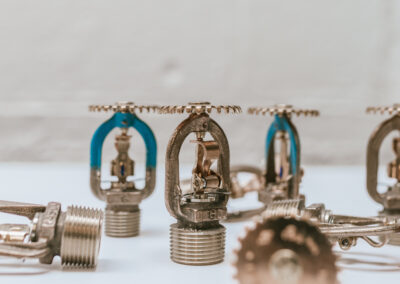A significant threat to the effectiveness of sprinkler systems is corrosion. To best combat it, we first need to understand what corrosion is and how it occurs. This blog covers fire sprinkler corrosion causes, how to detect it, and ways to prevent it from affecting system integrity.
What Causes Fire Sprinkler Corrosion?
Corrosion in sprinkler systems can occur due to a range of factors, but most of the time, oxygen is likely to blame. This is due to oxidation. Oxidation is a rust-forming process where trapped oxygen reacts with the iron metal sprinkler piping to form iron oxides, which we know as “rust”. Unchecked, corrosion inevitably progresses to the formation of pinhole leaks, or accidental sprinkler discharges. As a matter of fact, sprinkler discharge can cause costly damage and compromise system integrity, putting lives at risk during a fire.
How Can I Spot Corrosion?
Identifying corrosion can vary in ease. During annual inspections, watch for exterior corrosion on pipes, fittings, and sprinklers, identified by its orangey-brown color and rough texture.
Detecting internal corrosion is more challenging, which is why an assessment of the internal condition of piping is required to be conducted every five years. Alongside this, signs of internal and external corrosion include water stains or leakage, indicating possible pinhole leaks in the piping.
I See Corrosion In My System. What Do I Do?
Typically, when corrosion compromises the sprinkler system, replacing the affected piping or sprinkler becomes necessary. In some cases where the corrosion has eaten away at most of the system, causing irreparable damage, the entire system would need to be replaced.
Still unsure about your next steps? Give us a call and our team is happy to assess.
Practices to Mitigate Future Pipe Corrosion
Corrosion is one of the biggest threats and challenges in the fire protection industry. Despite its threat, numerous property owners neglect proactive measures to mitigate the problem until substantial damage emerges. All in all, establishing a corrosion control strategy is important to avoid costly repairs and ensure the functionality of your property’s sprinkler system.
Therefore, to mitigate the risks associated with corrosion in sprinkler systems, consider the following preventative measures:
1. Regular Inspections and Maintenance: Addressing issues early is key to preventing extensive damage and ensuring systems operate effectively in a fire. Regular fire sprinkler inspections, testing, and maintenance also help building owners avoid preventable regulatory code violations and adhere to NPFA 25 which require regular inspections and testing to identify early signs of corrosion.
2. Consider Nitrogen: Elevating nitrogen levels within your system’s piping serves to diminish dissolved oxygen content. This reduction in oxygen concentration prevents corrosion in the piping. Moreover, by curtailing the solids made by the dissolved oxygen, bacterial growth slows significantly, mitigating the risk of microbiologically influenced corrosion as well. This approach is effective for wet and dry systems alike.
Various nitrogen systems are available. Dry and pre-action systems typically employ nitrogen generators, while wet systems use portable nitrogen cylinders for inerting. Nitrogen generators ensure an uninterrupted supply of on-demand nitrogen. Common features across all generators include:
- Retrofit capability for older systems
- Oxygen elimination in both black steel and galvanized steel piping systems
3. Air Venting: NFPA 13, Standard for the Installation of Sprinkler System, requires a vent to be located at a high point in the system to allow air to be removed by either a manual or automatic valve. This practice, which is particularly beneficial on wet pipe sprinkler systems, lessens corrosion activity. The air venting valve’s primary purpose is to expel trapped air during system fill-ups, thereby minimizing oxygen presence and subsequently mitigating metal corrosion.
4. Corrosion Monitoring: Corrosion monitoring equipment is a way to determine if corrosion is occurring in your system. This specialized equipment is designed to notify you of any onset corrosion within the piping of your sprinkler system. Its advantages include:
- Automatic notification once corrosion occurs
- Detection capability in both wet and dry pipe systems
- Installed at locations where corrosion tends to be worst and most common
- Easy installation
All things considered, if you have more questions about corrosion in your sprinkler system or want to learn more about solutions for corrosion, please contact Ryan Fireprotection, or register for our upcoming virtual training session on September 25th to discuss corrosion in both wet and dry sprinkler systems.

